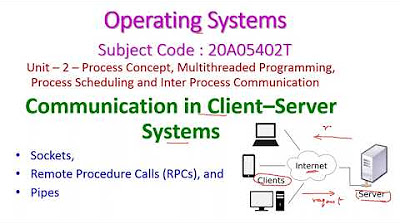Remote Procedure Call (RPC) - IOT - Pascasarjana STMIK Handayani
Summary
TLDRThis video discusses Remote Procedure Call (RPC), a method used to access and execute procedures on a remote server, commonly applied in IoT development. The instructor explains how RPC helps manage large procedures by centralizing them on a server, allowing multiple clients to access shared resources. It introduces the three layers of RPC architecture (top, intermediate, and lowest) and their roles in communication. The video also touches on real-world applications of RPC, such as using tools like TeamViewer for remote control, highlighting its benefits and challenges in system administration and networking.
Takeaways
- 💻 RPC (Remote Procedure Call) is a method allowing a procedure on one computer to be accessed by another computer.
- 🔧 RPC is crucial for developing IoT systems, especially for devices with limited memory like Arduino or Raspberry Pi.
- 🖥️ RPC allows the server to store and execute procedures, making them accessible to multiple client machines.
- 📡 Servers in RPC setups must always be ready to receive client requests and respond by providing access to their stored procedures.
- ⚙️ RPC uses sockets for communication between clients and servers, and clients can request information about available ports via name servers.
- 🔒 Three layers of RPC architecture include the highest layer, intermediate layer, and lowest layer. The highest layer integrates directly with the OS.
- 🔌 The intermediate layer of RPC is commonly used as it can be installed on servers without native RPC support and avoids direct socket handling.
- 🔗 The lowest layer of RPC manages sockets and system calls but is not commonly used due to its simplicity and lack of detailed service handling.
- 📶 Network communication in RPC involves sending client requests across the network, which are handled by the server and processed to return the appropriate response.
- 🔍 An example of RPC usage is remote desktop software like TeamViewer, where a user can remotely control another computer via network connections.
Q & A
What is RPC (Remote Procedure Call)?
-RPC, or Remote Procedure Call, is a method that allows a program to execute a procedure on another computer over a network, without needing to develop or store the procedure on the client machine.
Why is RPC important in IoT development?
-RPC is essential in IoT development because devices like Arduino or other small systems often have limited memory. By using RPC, large or complex procedures can be hosted on a server and accessed by these smaller devices, saving memory and processing power.
How does RPC benefit client-server architectures?
-RPC allows the server to offer procedures that can be accessed by multiple clients. This centralizes control and execution of procedures, enabling efficient use of server resources while reducing the need for large-scale development on the client side.
What role does a 'socket' play in RPC communication?
-A socket is the communication endpoint in RPC, where the server listens for client requests. Clients connect to the socket to request procedures hosted on the server, and data is transmitted back and forth through this connection.
What is the purpose of a 'port mapper' in RPC?
-A port mapper helps clients find the correct port number where the desired procedure is hosted on the server. This simplifies the process for the client to locate and connect to the correct RPC service.
What are the three layers of RPC architecture?
-The three layers of RPC architecture are: 1) The High Layer (interfacing with the OS and network), 2) The Intermediate Layer (implementing the actual RPC), and 3) The Lower Layer (handling sockets and system calls).
What is the High Layer in RPC, and how does it function?
-The High Layer interacts directly with the operating system and network, providing services closely tied to system operations. It is often integrated into the system and is widely used in RPC programs due to its deep connection with the OS.
What is the Intermediate Layer in RPC?
-The Intermediate Layer implements the core RPC functionality, allowing for the creation and management of remote procedures. This layer is installed independently on servers, providing RPC services without requiring direct interaction with sockets.
What are some challenges in implementing RPC on different operating systems?
-Challenges arise when adapting RPC to different operating systems, as varying system architectures may require specific adjustments to ensure proper communication, particularly in how system calls and socket management are handled.
What is an example of an application using RPC technology?
-An example of an application using RPC is TeamViewer, which allows users to remotely control a computer over a network, leveraging RPC-like techniques to send commands and receive responses between the client and the server.
Outlines

Cette section est réservée aux utilisateurs payants. Améliorez votre compte pour accéder à cette section.
Améliorer maintenantMindmap

Cette section est réservée aux utilisateurs payants. Améliorez votre compte pour accéder à cette section.
Améliorer maintenantKeywords

Cette section est réservée aux utilisateurs payants. Améliorez votre compte pour accéder à cette section.
Améliorer maintenantHighlights

Cette section est réservée aux utilisateurs payants. Améliorez votre compte pour accéder à cette section.
Améliorer maintenantTranscripts

Cette section est réservée aux utilisateurs payants. Améliorez votre compte pour accéder à cette section.
Améliorer maintenant5.0 / 5 (0 votes)






